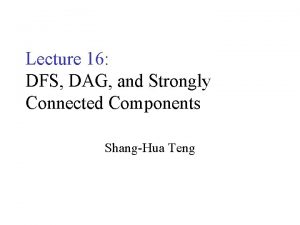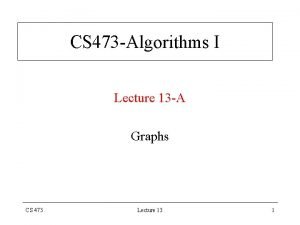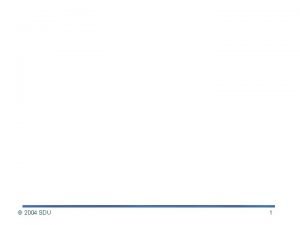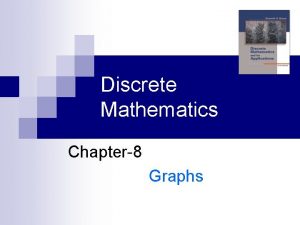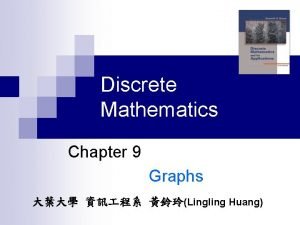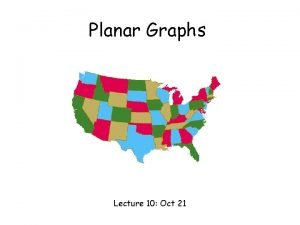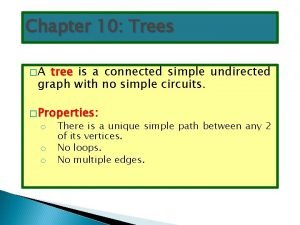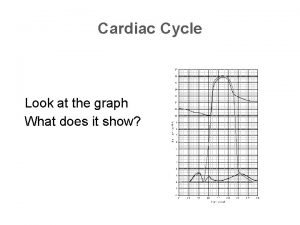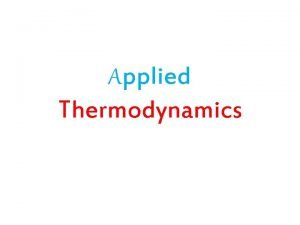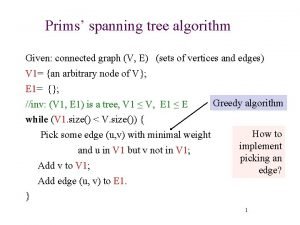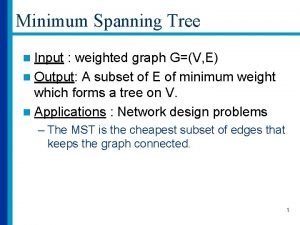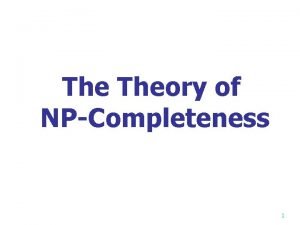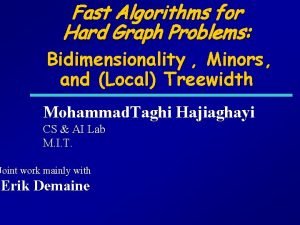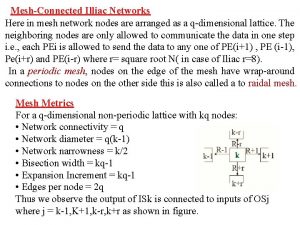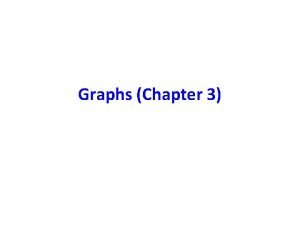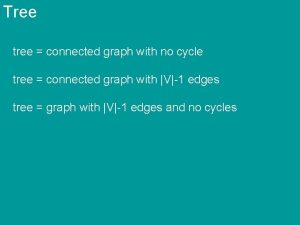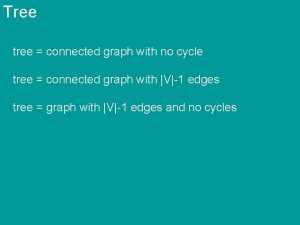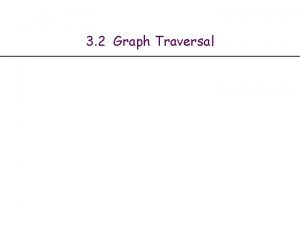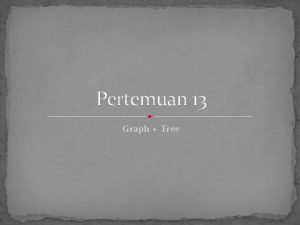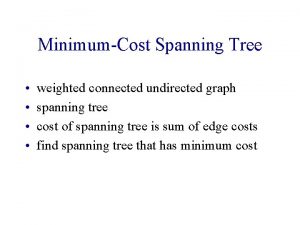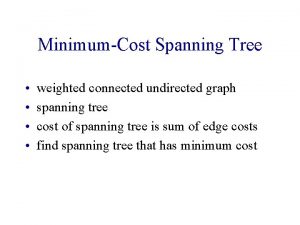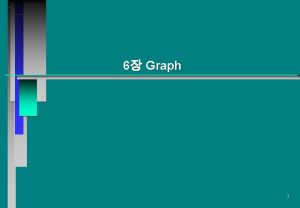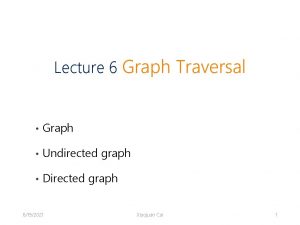Tree tree connected graph with no cycle tree






























![Union-Find S[1. . n] for i 1 to n do S[i] i Find-Set(u) return Union-Find S[1. . n] for i 1 to n do S[i] i Find-Set(u) return](https://slidetodoc.com/presentation_image_h2/ebc1d14dd8f187d1032d00d2a3abb439/image-31.jpg)
![Union-Find S[1. . n] for i 1 to n do S[i] i Find-Set(u) return Union-Find S[1. . n] for i 1 to n do S[i] i Find-Set(u) return](https://slidetodoc.com/presentation_image_h2/ebc1d14dd8f187d1032d00d2a3abb439/image-32.jpg)


![Union-Find 2 n=|V| S[1. . n] for i 1 to n do S[i] i Union-Find 2 n=|V| S[1. . n] for i 1 to n do S[i] i](https://slidetodoc.com/presentation_image_h2/ebc1d14dd8f187d1032d00d2a3abb439/image-35.jpg)
![Union-Find 2 n=|V| S[1. . n] for i 1 to n do S[i] i Union-Find 2 n=|V| S[1. . n] for i 1 to n do S[i] i](https://slidetodoc.com/presentation_image_h2/ebc1d14dd8f187d1032d00d2a3abb439/image-36.jpg)
![Union-Find 2 n=|V| S[1. . n] for i 1 to n do S[i] i Union-Find 2 n=|V| S[1. . n] for i 1 to n do S[i] i](https://slidetodoc.com/presentation_image_h2/ebc1d14dd8f187d1032d00d2a3abb439/image-37.jpg)
![Union-Find 2 n=|V| S[1. . n] for i 1 to n do S[i] i Union-Find 2 n=|V| S[1. . n] for i 1 to n do S[i] i](https://slidetodoc.com/presentation_image_h2/ebc1d14dd8f187d1032d00d2a3abb439/image-38.jpg)














![Minimum weight spanning trees for i 1 to n do C[i] C[0]=0 S={} while Minimum weight spanning trees for i 1 to n do C[i] C[0]=0 S={} while](https://slidetodoc.com/presentation_image_h2/ebc1d14dd8f187d1032d00d2a3abb439/image-53.jpg)
![Minimum weight spanning trees for i 1 to n do C[i] C[0]=0 O(n) S={} Minimum weight spanning trees for i 1 to n do C[i] C[0]=0 O(n) S={}](https://slidetodoc.com/presentation_image_h2/ebc1d14dd8f187d1032d00d2a3abb439/image-54.jpg)
![Minimum weight spanning trees for i 1 to n do C[i] C[0]=0 O(n) S={} Minimum weight spanning trees for i 1 to n do C[i] C[0]=0 O(n) S={}](https://slidetodoc.com/presentation_image_h2/ebc1d14dd8f187d1032d00d2a3abb439/image-55.jpg)
![Minimum weight spanning trees for i 1 to n do C[i] C[0]=0 O(log n) Minimum weight spanning trees for i 1 to n do C[i] C[0]=0 O(log n)](https://slidetodoc.com/presentation_image_h2/ebc1d14dd8f187d1032d00d2a3abb439/image-56.jpg)


- Slides: 58

Tree tree = connected graph with no cycle tree = connected graph with |V|-1 edges tree = graph with |V|-1 edges and no cycles

Tree tree = connected graph with no cycle tree = connected graph with |V|-1 edges tree = graph with |V|-1 edges and no cycles no cycle vertex of degree 1 |V|-1 edges vertex of degree 1 connected no vertex of degree 0 (unless |V|=1)

no cycle vertex of degree 1 Supose not, i. e. , all vertices of degree 2, yet no cycle. Let v 1, . . . , vt be the longest path vt has 2 -neighbors, one different from vt-1. Why cannot take v 1, . . . , vt, u ? Cycle. Contradiction.

|V|-1 edges vertex of degree 1 Suppose all degrees 2. Then |E|=(1/2) deg(v) |V| v V Contradiction. Done.

connected no vertex of degree 0 (unless |V|=1)

Tree connected graph with no cycle connected graph with |V|-1 edges and no cycles no cycle vertex of degree 1 |V|-1 edges vertex of degree 1 connected no vertex of degree 0 (unless |V|=1)

connected graph with no cycle connected graph with |V|-1 edges Induction on |V|. Base case |V|=1. Let G be connected with no cycles. Then G has vertex v of degree 1. Let G’ = G – v. Then G’ is connected and has no cycle. By IH G’ has |V|-2 edges and hence G has |V|-1 edges.

connected graph with no cycle connected graph with |V|-1 edges Induction on |V|. Base case |V|=1. Let G be connected |V|-1 edges. Then G has vertex v of degree 1. Let G’ = G – v. Then G’ is connected and has |V’|-1 edges. By IH G’ has no cycle. Hence G has no cycle.

connected graph with no cycle connected graph with |V|-1 edges and no cycles Assume |V|-1 edges and no cycles. Let |G 1|, . . . , |Gk| be the connected components. Then |E_i| = |V_i| - 1, hence |E| = |V| - k. Thus k = 1.

Spanning trees

Spanning trees

Spanning trees

Spanning trees How many spanning trees ?

Spanning trees How many spanning trees ? 4

Spanning trees How many spanning trees ?

Spanning trees How many spanning trees ? 8

Minimum weight spanning trees 4 3 2 3 5 7 1 6 6 4 2

Minimum weight spanning trees 4 3 2 3 5 7 1 6 6 4 2

Minimum weight spanning trees 4 3 2 3 5 7 1 6 6 4 2

Minimum weight spanning trees 4 3 2 3 5 7 1 6 6 4 2

Minimum weight spanning trees 4 3 2 3 5 7 1 6 6 4 2

Minimum weight spanning trees 4 3 2 3 5 7 1 6 6 4 2

Minimum weight spanning trees Kruskal’s algorithm 1) sort the edges by weight 2) add edges in order if they do not create cycle

Kruskal’s algorithm 1) sort the edges by weight 2) add edges in order if they do not create cycle K = MST output by Kruskal T = optimal MST Is K = T ?

Kruskal’s algorithm 1) sort the edges by weight 2) add edges in order if they do not create cycle K = MST output by Kruskal T = optimal MST Is K = T ? no – e. g. if all edge-weights are the same many optima

Kruskal’s algorithm 1) sort the edges by weight 2) add edges in order if they do not create cycle K = MST output by Kruskal T = optimal MST Assume all edge weights are different. Then K=T. (In particular, unique optimum)

Kruskal’s algorithm 1) sort the edges by weight 2) add edges in order if they do not create cycle K = MST output by Kruskal T = optimal MST G connected, e in a cycle G-e connected

Kruskal’s algorithm K = MST output by Kruskal T = optimal MST G connected, e in a cycle G-e connected e the edge of the smallest weight in K-T. Consider T+e.

Kruskal’s algorithm e the edge of the smallest weight in K-T. Consider T+e. Case 1: all edgeweights in C smaller that we Case 2: one edgeweight in C larger that we

Kruskal’s algorithm 1) sort the edges by weight 2) add edges in order if they do not create cycle Need to maintain components. Find-Set(u) Union(u, v)
![UnionFind S1 n for i 1 to n do Si i FindSetu return Union-Find S[1. . n] for i 1 to n do S[i] i Find-Set(u) return](https://slidetodoc.com/presentation_image_h2/ebc1d14dd8f187d1032d00d2a3abb439/image-31.jpg)
Union-Find S[1. . n] for i 1 to n do S[i] i Find-Set(u) return S[u] Union(u, v) a S[u] for i 1 to n do if S[i]=a then S[i] S[v]
![UnionFind S1 n for i 1 to n do Si i FindSetu return Union-Find S[1. . n] for i 1 to n do S[i] i Find-Set(u) return](https://slidetodoc.com/presentation_image_h2/ebc1d14dd8f187d1032d00d2a3abb439/image-32.jpg)
Union-Find S[1. . n] for i 1 to n do S[i] i Find-Set(u) return S[u] O(1) Union(u, v) a S[u] for i 1 to n do if S[i]=a then S[i] S[v] O(n)

Kruskal’s algorithm Find-Set(u) O(1) Union(u, v) O(n) Kruskal’s algorithm 1) sort the edges by weight 2) add edges in order if they do not create cycle

Kruskal’s algorithm Find-Set(u) O(1) Union(u, v) O(n) O(E log E + V^2) Kruskal’s algorithm 1) sort the edges by weight 2) add edges in order if they do not create cycle
![UnionFind 2 nV S1 n for i 1 to n do Si i Union-Find 2 n=|V| S[1. . n] for i 1 to n do S[i] i](https://slidetodoc.com/presentation_image_h2/ebc1d14dd8f187d1032d00d2a3abb439/image-35.jpg)
Union-Find 2 n=|V| S[1. . n] for i 1 to n do S[i] i Find-Set(u) while (S[u] u) do u S[u] Union(u, v) S[Find-Set(u)] Find-Set(v) v u
![UnionFind 2 nV S1 n for i 1 to n do Si i Union-Find 2 n=|V| S[1. . n] for i 1 to n do S[i] i](https://slidetodoc.com/presentation_image_h2/ebc1d14dd8f187d1032d00d2a3abb439/image-36.jpg)
Union-Find 2 n=|V| S[1. . n] for i 1 to n do S[i] i Find-Set(u) while (S[u] u) do u S[u] Union(u, v) S[Find-Set(u)] Find-Set(v) v u
![UnionFind 2 nV S1 n for i 1 to n do Si i Union-Find 2 n=|V| S[1. . n] for i 1 to n do S[i] i](https://slidetodoc.com/presentation_image_h2/ebc1d14dd8f187d1032d00d2a3abb439/image-37.jpg)
Union-Find 2 n=|V| S[1. . n] for i 1 to n do S[i] i Find-Set(u) while (S[u] u) do u S[u] Union(u, v) S[Find-Set(u)] Find-Set(v) O(n)
![UnionFind 2 nV S1 n for i 1 to n do Si i Union-Find 2 n=|V| S[1. . n] for i 1 to n do S[i] i](https://slidetodoc.com/presentation_image_h2/ebc1d14dd8f187d1032d00d2a3abb439/image-38.jpg)
Union-Find 2 n=|V| S[1. . n] for i 1 to n do S[i] i Find-Set(u) while (S[u] u) do u S[u] O(log n) Union(u, v) O(log n) u Find-Set(u); v Find-Set(v); if D[u]<D[v] then S[u] v if D[u]>D[v] then S[v] u if D[u]=D[v] then S[u] v; D[v]++

Kruskal’s algorithm Find-Set(u) O(log n) Union(u, v) O(log n) Kruskal’s algorithm 1) sort the edges by weight 2) add edges in order if they do not create cycle

Kruskal’s algorithm Find-Set(u) O(log n) Union(u, v) O(log n) O(E log E + (E+V)log V) Kruskal’s algorithm 1) sort the edges by weight 2) add edges in order if they do not create cycle

Kruskal’s algorithm log E log V 2 = 2 log V = O(log V) O((E+V) log V) O(E log E + (E+V)log V) Kruskal’s algorithm 1) sort the edges by weight 2) add edges in order if they do not create cycle

Minimum weight spanning trees 4 3 2 3 5 7 1 6 6 4 2

Minimum weight spanning trees 4 3 2 3 5 7 1 6 6 4 2

Minimum weight spanning trees 4 3 2 3 5 7 1 6 6 4 2

Minimum weight spanning trees 4 3 2 3 5 7 1 6 6 4 2

Minimum weight spanning trees 4 3 2 3 5 7 1 6 6 4 2

Minimum weight spanning trees 4 3 2 3 5 7 1 6 6 4 2

Minimum weight spanning trees Prim’s algorithm 1) S {1} 2) add the cheapest edge {u, v} such that u S and v SC S S {v} (until S=V)

Minimum weight spanning trees 1) S {1} 2) add the cheapest edge {u, v} such that u S and v SC S S {v} (until S=V) P = MST output by Prim T = optimal MST Is P = T ? assume all the edgeweights different

Minimum weight spanning trees P = MST output by Prim T = optimal MST P=T assuming all the edgeweights different v 1, v 2, . . . , vn order added to S by Prim smallest i such that an edge e E connecting S={v 1, . . . , vi} to SC different in T than in Prim (f)

Minimum weight spanning trees e S T SC smallest i such that an edge e E connecting S={v 1, . . . , vi} to SC different in T than in Prim (f)

Minimum weight spanning trees e S T+f SC f smallest i such that an edge e E connecting S={v 1, . . . , vi} to SC different in T than in Prim (f)
![Minimum weight spanning trees for i 1 to n do Ci C00 S while Minimum weight spanning trees for i 1 to n do C[i] C[0]=0 S={} while](https://slidetodoc.com/presentation_image_h2/ebc1d14dd8f187d1032d00d2a3abb439/image-53.jpg)
Minimum weight spanning trees for i 1 to n do C[i] C[0]=0 S={} while S V do j smallest such that j SC and C[j] is minimal S S { j } for u neighbors of j do if w[{j, u}] < C[u] then C[u] w[{j, u}]; P[u] j
![Minimum weight spanning trees for i 1 to n do Ci C00 On S Minimum weight spanning trees for i 1 to n do C[i] C[0]=0 O(n) S={}](https://slidetodoc.com/presentation_image_h2/ebc1d14dd8f187d1032d00d2a3abb439/image-54.jpg)
Minimum weight spanning trees for i 1 to n do C[i] C[0]=0 O(n) S={} while S V do j smallest such that j SC and C[j] is minimal S S { j } for u neighbors of j do if w[{j, u}] < C[u] then C[u] w[{j, u}]; P[u] j
![Minimum weight spanning trees for i 1 to n do Ci C00 On S Minimum weight spanning trees for i 1 to n do C[i] C[0]=0 O(n) S={}](https://slidetodoc.com/presentation_image_h2/ebc1d14dd8f187d1032d00d2a3abb439/image-55.jpg)
Minimum weight spanning trees for i 1 to n do C[i] C[0]=0 O(n) S={} while S V do j smallest such that j SC and C[j] is minimal S S { j } for u neighbors of j do if w[{j, u}] < C[u] then C[u] w[{j, u}]; P[u] j O(V 2 + E) = O(V 2)
![Minimum weight spanning trees for i 1 to n do Ci C00 Olog n Minimum weight spanning trees for i 1 to n do C[i] C[0]=0 O(log n)](https://slidetodoc.com/presentation_image_h2/ebc1d14dd8f187d1032d00d2a3abb439/image-56.jpg)
Minimum weight spanning trees for i 1 to n do C[i] C[0]=0 O(log n) S={} while S V do j smallest such that j SC and C[j] is minimal S S { j } for u neighbors of j do if w[{j, u}] < C[u] then C[u] w[{j, u}]; P[u] j O((E+V)log V) using heap

Minimum weight spanning trees Kruskal Prim O( (E+V) log V)

Minimum weight spanning trees Kruskal O( (E+V) log V) if edges already sorted then O(E log*V) Prim O( (E+V) log V) can be made O(E + V log V) using Fibonacci heaps
 A tree is a connected graph without any circuits
A tree is a connected graph without any circuits Wye and delta connections
Wye and delta connections In a y-connected source feeding a ∆-connected load,
In a y-connected source feeding a ∆-connected load, In a ∆-connected source feeding a y-connected load
In a ∆-connected source feeding a y-connected load Strongly connected graph
Strongly connected graph Gscc graph
Gscc graph Connected acyclic graph
Connected acyclic graph Semiconnected graph
Semiconnected graph Isomorphism of graphs in discrete mathematics
Isomorphism of graphs in discrete mathematics Connected simple graph
Connected simple graph Algebra 1 topic 2 test answers
Algebra 1 topic 2 test answers Euler's formula for planar graphs
Euler's formula for planar graphs A tree is a connected?
A tree is a connected? Handshaking theorem
Handshaking theorem Wait-for graph
Wait-for graph Chrono cycle graph
Chrono cycle graph Cells undergoing mitosis
Cells undergoing mitosis Cardiac cycle graph
Cardiac cycle graph Cell cycle graph
Cell cycle graph Significance of cell cycle
Significance of cell cycle Motivation cycle in psychology
Motivation cycle in psychology Water cycle brain pop
Water cycle brain pop Significance of biogeochemical cycle
Significance of biogeochemical cycle Difference between phosphorus cycle and carbon cycle
Difference between phosphorus cycle and carbon cycle Difference between open cycle and closed cycle gas turbine
Difference between open cycle and closed cycle gas turbine Reservation table in computer architecture
Reservation table in computer architecture Chapter 5 principles of engine operation
Chapter 5 principles of engine operation Grille évaluation handball cycle 3
Grille évaluation handball cycle 3 Magneto hydro dynamics power generation ppt
Magneto hydro dynamics power generation ppt Cycle 3 cycle de consolidation
Cycle 3 cycle de consolidation Cycle 3 cycle de consolidation
Cycle 3 cycle de consolidation Water cycle the hydrologic cycle
Water cycle the hydrologic cycle Difference between dijkstra and prim
Difference between dijkstra and prim Minimum spanning tree weighted graph
Minimum spanning tree weighted graph Spanning tree of a graph
Spanning tree of a graph Query tree and query graph
Query tree and query graph Spanning tree of a graph
Spanning tree of a graph Query tree and query graph
Query tree and query graph Treewidth
Treewidth Connected strategy worksheet template
Connected strategy worksheet template Trimble connected community
Trimble connected community Line current and phase current
Line current and phase current Are all the oceans connected
Are all the oceans connected Generally restful,like the horizon,where the sky meets land
Generally restful,like the horizon,where the sky meets land Connected particles a level maths
Connected particles a level maths Roman empire specialization
Roman empire specialization Precis is a french word
Precis is a french word Do great lakes connect to ocean
Do great lakes connect to ocean Simply connected domain
Simply connected domain It is a spoken or written account of connected events
It is a spoken or written account of connected events Contoh model connected di paud
Contoh model connected di paud Isk osj
Isk osj How is manorialism connected to feudalism
How is manorialism connected to feudalism Lumen connected security
Lumen connected security Getting connected ionic compounds
Getting connected ionic compounds Backpropagation cnn
Backpropagation cnn Ibm connected vehicle
Ibm connected vehicle Connected nation michigan
Connected nation michigan Topological sort can be implemented by?
Topological sort can be implemented by?





